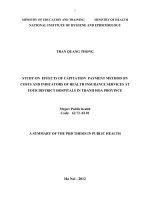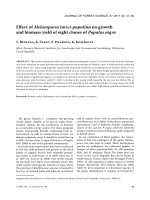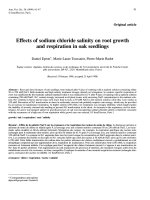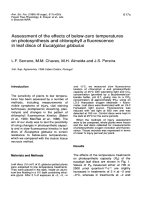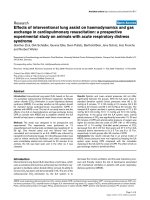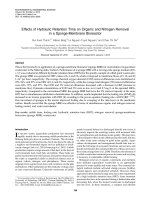Effects of moringa (moringa oleifera) on growth and its antimicrobial activities against pathogenic bacteria infecting grass carp
Bạn đang xem bản rút gọn của tài liệu. Xem và tải ngay bản đầy đủ của tài liệu tại đây (4.86 MB, 77 trang )
VIETNAM NATIONAL UNIVERSITY OF AGRICULTURE
PHETPHAILIN SAISOMBUT
EFFECTS OF MORINGA (MORINGA OLEIFERA) ON
GROWTH AND ITS ANTIMICROBIAL ACTIVITIES
AGAINST PATHOGENIC BACTERIA INFECTING
GRASS CARP
Major:
Aquaculture
Code:
8 62 03 01
Supervisor:
Dr. Nguyen Ngoc Tuan
AGRICULTURAL UNIVERSITY PRESS - 2021
HỌC VIỆN NÔNG NGHIỆP VIỆT NAM
PHETPHAILIN SAISOMBUT
NGHIÊN CỨU ẢNH HƯỞNG CỦA CÂY CHÙM NGÂY
(MORINGA OLEIFERA) LÊN SINH TRƯỞNG VÀ KHẢ
NĂNG ỨC CHẾ MỘT SỐ LOẠI VI KHUẨN GÂY BỆNH
Ở CÁ TRẮM CỎ
Ngà nh:
Nuôi trồng thủy sản
Mã số :
8 62 03 01
Người hướng dẫn: TS. Nguyễn Ngọc Tuấn
NHÀ XUẤT BẢN HỌC VIỆN NÔNG NGHIỆP - 2021
STATEMENT
I confirm that I wrote my master thesis titled: “Effects of Moringa (Moringa
oleifera) on growth and its antimicrobial activities against pathogenic bacteria infecting
grass carp” case study in Viet Nam. It done by myself and there were used only sources
that are listed in the part of reference. The result of my research and follow-up during
my internship, ensure reliability, accuracy and honesty.
The data and results in the thesis are true and never been published in any
previous research. Documents for analysis, commentary and evaluation collected from
different sources are clearly traced and cited. In addition, the topic also uses some
comments, reviews as well as data of the author or some other organization and
organization are also shown in the references. Any help from individuals, agencies and
organizations is thanks.
All invalid copies, violating the regulations of writing essays or fraud, I will be
entirely responsible.
In Ha Noi on date
/2021
Supervisor
Author
Dr. Nguyen Ngoc Tuan
Phetphailin SAISOMBUT
Certified by faculty of Fisheries, VNUA
i
ACKNOWLEDGEMEN
First of all, I would like to express my sincere gratitude to the Viet Nam National
University Agricultrue which offered me the opportunity to get financial support for my
education.
I would like to express my sincere gratitude to Dr. Nguyen Ngoc Tuan
enthusiastically guided, edited, spent a lot of effort and time and created conditions for
me during the process of studying and implementing the thesis.
I would like to express my sincere gratitude to staff of the Faculty of Fisheries,
Vietnam National University of Agriculture. Especially Dr. Kim Van Van Dean of the
Faculty, Dr. Truong Dinh Hoai vice-dean and teacher, created favorable conditions and
enthusiastically helped me in the process of studying, implementing the thesis and
completing the thesis.
I would like to express my special thanks to Dr. Doan Thi Nhinh, Dr. Le Viet
Dung and the students of the Laboratory, Department of Aquatic Diseases, Department
of Fisheries for their help and support during the implementation of this experiment.
I cannot forget that the Faculty of Agriculture, Laos National University always
helped and monitored my studies during my study abroad in Vietnam. Thank you Prof.
Thonglom PHOMMAVONG vice-dean of Agriculture and thanks Dr. Phouvin
PHOUSAVANH Head of Livestock and Fisheries Department, special thanks are
deserved to all staff of Faculty of Agriculture and also all staff of Department of
Livestock and Fisheries in Laos for all kind of help I got from them. I was very lucky
realize my experimental work there.
Finally I thank a lot to my family for giving me my life and for supporting,
helping and never-ending encouragement during me stay in Vietnam.
ii
LỜI CẢM ƠN
Trong suốt thời gian học tập, nghiên cứu và hồn thành luận văn, tơi đã nhận được
sự hướng dẫn, chỉ bảo tận tình, giúp đỡ, động viên của các thầy cô giáo, cán bộ, nhân
viên, đồng nghiệp, bạn bè và gia đình.
Nhân dịp hồn thành luận văn, cho phép tơi được bày tỏ lịng kính trọng và biết
ơn sâu sắc TS. Nguyễn Ngọc Tuấn đã tận tình hướng dẫn, chỉnh sửa, dành nhiều công
sức, thời gian và tạo điều kiện cho tơi trong suốt q trình học tập và thực hiện đề tài.
Tơi xin bày tỏ lịng biết ơn chân thành tới tập thể lãnh đạo, cán bộ viên Khoa Thủy
sản, Học viện Nông nghiệp Việt Nam. Đặc biệt là TS. Kim Văn Vạn trưởng khoa Thủy
Sản, TS. Trương Đình Hồi phó khoa Thủy Sản và các giáo viên trong khoa đã tạo điều
kiện, tận tình giúp đỡ tơi trong q trình học tập, thực hiện đề tài và hồn thành luận văn.
Tơi xin chân thành cảm ơn ThS. Đoàn Thị Nhinh, TS. Lê Việt Dũng và các bạn
sinh viên phịng thí nghiệm, tại khoa thủy sản đã giúp đỡ và hỗ trợ tơi trong suốt q
trình thực hiện thí nghiệm của đề tài này.
Tơi khơng thể qn được Khoa Nông nghiêp, Đại học Quốc gia Lào luôn giúp đỡ,
theo dõi trong việc học tập của tôi trong thời gian du học tại Việt Nam. Cảm ơn PGS.
Thonglom PHOMMAVONG phó trưởng khoa Nơng nghiệp và cảm ơn Dr. Phouvin
PHOUSAVANH trưởng bộ môn chăn nuôi và thủy sản cùng tập thể giáo viên cán bộ
viên luôn lo và theo dõi việc học tập tôi và luôn cổ vũ tôi
Cuối cùng tơi xin chân thành cảm ơn gia đình, người thân, bạn bè, đồng nghiệp đã
tạo mọi điều kiện thuận lợi và giúp đỡ tôi về mọi mặt, động viên khuyến khích tơi hồn
thành luận văn.
Hà Nội, ngày tháng năm 2021
Tác giả luận văn
Phetphailin SAISOMBUT
iii
ຄຳຂອບໃຈ
ຜ່ານຈາກການສຶກສາຄົ້ນຄວ້າບົດວິທະຍານິພົນ
ຂອງຂ້າພະເຈົ້າໃນຄັ້ງນີ້
ແມ່ນມີຄວາມສຳຄັນ
ມີຄວາມໝາຍອັນລ້ຳຄ່າ
ແລະ
ເຊິ່ງເປັນບົດຮຽນ,
ປະສົບການອັນຍິ່ງໃຫຍ່ໃນບົດວິທະຍານິພົນຄັ້ງນີ້
ຈົນສາມາດໄດ້ຮັບຜົນສຳເລັດຕາມຄາດໝາຍຢ່າງສົມບູນ
ເຊິ່ງຄວາມສຳເລັດດັ່ງກ່າວນີ້
ຊ່ວຍເຫຼືອ
ແລະ
ກໍ່ເກີດມາຈາກການຊຸກຍູ້,
ການຊ່ວຍເຫຼືອຈາກຫຼາຍພາກສ່ວນ.
ສະນັ້ນ,
ຂ້າພະເຈົ້າຈຶ່ງຖືເອົາໂອກາດນີ້
ສະແດງຄວາມຮູ້ບຸນຄຸນອັນສູງສົ່ງ ແລະ ສະແດງຄວາມຂອບໃຈມານຳ.
ຂໍຂອບໃຈມາຍັງ
ສະຖາບັນກະສິກຳຫວຽດນາມ,
ຄະນະປະມົງ
ທີ່ໃຫ້ສະຖານທີ່ການສຶກສາ ແລະ ການຄົ້ນຄວ້າວິໄຈໃນຄັ້ງນີ້.
ຂໍຂອບໃຈ ແລະ ຮູ້ບຸນຄຸນມາຍັງອາຈານທີ່ປຶກສາ ທ່ານ ປອ.
NGUYEN
NGOC
TUAN
ທີ່ໄດ້ເອົາໃຈໃສ່
ຊີ້ນຳຕະຫຼອດຈົນປັບປຸງແກ້ໄຂ
ດ້ວຍຄວາມເອົາໃຈໃສ່ຢ່າງດີ
ໃຫ້ຄຳປຶກສາ,
ຂໍ້ບົກພ່ອງຕ່າງໆ
ແຕ່ຕົ້ນຈົນເຖິງສຸດທ້າຍ
ຂອງຄວາມສຳເລັດໃນການຂຽນບົດນິພົນທີ່ຄົບຖ້ວນສົມບູນຢ່າງຈ
ົບງາມ.
ພ້ອມດຽວກັນນັ້ນ, ຂໍສະແດງຄວາມຂອບໃຈມາຍັງ ອຈ ທຸກໆທ່ານ
ພາກວິຊາການປະມົງ
ທີ່ໄດ້ສິດສອນວິຊາຄວາມຮູ້ຕ່າງໆໃຫ້ແກ່ຂ້າພະເຈົ້າ.
ໂດຍສະເພາະແມ່ນ ທ່ານ ປອ. KIM VAN VAN ຫົວໜ້າພາກວິຊາ, ທ່ານ
ປອ.
TRUONG
DINH
HOAI
ຮອງພາກວິຊາ
ແລະ
ອຈ
ທຸກໆທ່ານທີ່ໄດ້ແນະນຳ ແລະ ສີດສອນຕະຫຼອດມາ.
ສະແດງຄວາມຮູ້ບຸນຄຸນມາຍັງ ທ່ານນາງ ປອ. DOAN THI NHINH
ທີ່ຄອຍໃຫ້ຄຳປຶກສາ,ກວດແກ້ບົດ,
ຊີ້ນຳວຽກງານການທົດລອງ
ຕັ້ງແຕ່ຕົ້ນຈົນຈົບການທົດລອງ; ຂອບໃຈມາຍັງ ທ່ານ ປອ. Le Viet
iv
Dung ທີ່ຊ່ວຍເຫລືອດ້ານສະຖານທີ່ການເຮັດງານທົດລອງຄັ້ງນີ້;
ຂອບໃຈມາຍັງບັນດານ້ອງໆນັກສຶກສາ
ປະຈຳຢູ່ຫ້ອງທົດລອງທີ່ໃຫ້ຄວາມຊ່ວຍເຫຼືອດ້ານວຽກງານການວ
ິໃຈ.
ຂ້າພະເຈົ້າບໍ່ສາມາດລືມໄດ້ຄະນະກະເສດສາດ,
ມະຫາວິທະຍາໄລແຫ່ງຊາດ
ທີ່ໄດ້ຄອຍຕິດການຮຽນການສຶກສາຂອງຂ້າພະເຈົ້າ
ແລະ
ຊ່ວຍເຫຼືອ ໃຫ້ຄຳປຶກສາໃນທຸກໆດ້ານ.
ພ້ອມດຽວກັນນັ້ນ
ຂອບໃຈມາຍັງ
ທ່ານ
ຮສ.
ທອງຫຼອມ
ພົມມະວົງ ຮອງຄະນະບໍດີ, ທ່ານ ປອ.ພູວິນ ພູສະຫວັນ ລວມໄປເຖິງ
ພະນັກງານ
ຄູອາຈານ
ພາກວິຊາລ້ຽງສັດ-ການປະມົງ
ໝົດທຸກຄົນ
ທີ່ຄອຍເປັນຫ່ວງເປັນໄຍ,
ຕິດຕາມການຮຽນການສຶກສາຂອງຂ້າພະເຈົ້າ
ພ້ອມທັງເປັນກຳລັງໃຈໃຫ້ແກ່ຂ້າພະເຈົ້າຕະຫຼອດມາ.
ສຸດທ້າຍ
ຂໍສະແດງຄວາມຮູ້ບຸນຄຸນມາຍັງ
ອ້າຍເອື້ຶອຍນ້ອງ,
ທີ່ຄອຍເບິ່ງແຍງ,
ຍາດພີ່ນ້ອງ,
ພໍ່ແມ່,
ໝູ່ເພື່ອນ
ຊຸກຍູ້ຊ່ວຍເຫຼືອຂ້າພະເຈົ້າຕະຫຼອດມາ;
ພ້ອມດຽວກັນນັ້ນບໍ່ອາດລືມໄດ້
ຄອບຄົວຂອງຂ້າພະເຈົ້າ
ຜູ້ທີ່ຄອຍໃຫ້ກຳລັງໃຈ,
ປຶກສາຫາລື,
ສະໜັບສະໜູນທຸກດ້ານບໍ່ວ່າຈະເປັນດ້ານຊັບສິນ
ແລະ
ດ້ານຈິດໃຈ
ໃນໄລຍະທີ່ຂ້າພະເຈົ້າໄດ້ສຶກສາຢູ່ທີ່ປະເທດຫວຽດນາມໃນໄລຍະສາ
ມປີ.
v
CONTENT
Statement ........................................................................................................................... i
Acknowledgemen ............................................................................................................. ii
Lời cảm ơn ....................................................................................................................... iii
ຄຳຂອບໃຈ ....................................................................................................................... iv
Content ............................................................................................................................. vi
List of acronyms and abbreviations ................................................................................. ix
Table of contents ............................................................................................................... x
Figure of contents ............................................................................................................ xi
Thesis abstract................................................................................................................. xii
Trích yếu luận văn ......................................................................................................... xiv
ບົດຄັດຫຍໍ້ .......................................................................................................... xvi
I.
Introduction ......................................................................................................... 1
II.
Literature review ................................................................................................. 3
2.1.
Origin of grass carp ............................................................................................... 3
2.1.1. Classification of grass carp .................................................................................... 3
2.1.2. Morphological characteristics................................................................................ 3
2.1.3. Habitat ................................................................................................................... 4
2.1.4. Nutritional characteristics ...................................................................................... 4
2.1.5. Growth characteristics ........................................................................................... 5
2.1.6. Biochemical characteristics of grass carp meat ..................................................... 5
2.1.7. The situation of grass carp farming in the world ................................................... 5
2.1.8. Status of grass carp farming in Vietnam ............................................................... 6
2.2.
Some diseases on grass carp .................................................................................. 6
2.2.1. Disease caused by virus on grass carp ................................................................... 6
2.2.2. Bacterial disease .................................................................................................... 7
2.2.3. Diseases caused by parasites ................................................................................. 8
2.3.
Antibiotics and antibiotic resistance in aquaculture ................................................... 9
2.3.1. Antibiotics used in aquaculture. ............................................................................ 9
2.3.2. Harmful effects of overuse of antibiotics ............................................................ 10
vi
2.3.3. Measures to limit antibiotic use ........................................................................... 11
2.4.
Effects of some herbs .......................................................................................... 12
2.5.
Moringa (Moringa oleifera) ................................................................................. 13
2.5.1. Taxonomy of Moringa ......................................................................................... 13
2.5.2. Nutritional value and benefits.............................................................................. 14
2.5.3. Important substances in moringa leaves .............................................................. 15
2.6.
Duckweed ............................................................................................................ 18
2.6.1. Important elements .............................................................................................. 19
2.6.2. Factors affecting duckweed growth. .................................................................... 19
III.
Materials and methods ...................................................................................... 21
3.1.
Location of the study ........................................................................................... 21
3.2.
Materials of the study .......................................................................................... 21
3.2.1. Feed, fish and bacteria ......................................................................................... 21
3.2.2. Materials of research ........................................................................................... 21
3.3.
Methodologies and experimental design ............................................................. 22
3.3.1. Experiment 1: Evaluation of the antibacterial ability of moringa to some
pathogenic bacteria. ............................................................................................. 22
3.3.2. LD50 determination of A. hydrophila ................................................................. 24
3.3.3. Experiment 2: Evaluation of the effect of moringa leaves on the growth of
grass carp. ............................................................................................................ 25
3.3.4. Experiment 3: Evaluation of the effect of moringa leaves on disease
resistance in grass carp. ....................................................................................... 27
3.4.
Statistical analysis................................................................................................ 28
IV.
Results and discussions ..................................................................................... 29
4.1.
Results on screening antibacterial activity of extracts from moringa on
common pathogenic bacteria infecting grass carp. .............................................. 29
4.2.
Determination of virulence of a. Hydrophila infecting grass carp ...................... 31
4.3.
Evaluation of the effect of moringa leaves on the growth of herbivorous
grass carp. ............................................................................................................ 33
4.3.1. Environmental factors in the growth experimental ............................................. 33
4.3.2. The effect of moringa leaves on the growth of herbivorous grass carp .............. 35
vii
4.4.
Effects of moringa on disease resistance of grass carp ....................................... 37
4.4.1. Temperature ......................................................................................................... 37
4.4.2. Evaluation of disease resistance of fish after use moringa as feed ...................... 38
V.
Conclusions and suggestions ............................................................................. 44
5.1.
Conclusions ......................................................................................................... 44
5.2.
Suggestions .......................................................................................................... 44
References ...................................................................................................................... 45
Appendices ..................................................................................................................... 53
viii
LIST OF ACRONYMS AND ABBREVIATIONS
AOAC
ASEAN
AWG
ANOVA
BHIB
CFU
CP
cm
ºC
m3
DW
DML
DNA
DO
FAO
FDW
FML
FW
FCR
g/mL
h
IW
Kg
LD50
mg/L
mg
mm
ml
µl
NaCl
KMnO4
PER
PCR
pH
%
RNA
SGR
SR
SPSS
TSA
WG
Assuciation of Official Analytical Chemists
Association of Southeast Asian Nations
Average Weight Gain
Analysis of Variance
Brain Heart Intusion Broth
Colony Forming Unit
Crude Protein
Centimeter
Celsius
Cubic meter
Duckweed
Dry moringa leaves
Deoxyribonucleic acid.
Dissolved Oxygen
Food and griculture Organization of the United Nations
Fresh Duck Weed
Fresh moringa leaves
Final weight
Feed Conversion Ratio
Gram per milliliter
Hour
Initial weight
Kilogram
Median lethal dose
Milligram per Liter
Milligram
Millimeter
Milliliter
Microliter
Sodium Chloride
Potassium permanganate
Protein efficiency ratio
Polymerase Chain Reaction
Potential of Hydrogen
Percentage
Ribonucleic Acid.
Specific Growth Rate
Survival Rate
Statistical Package for the Social Sciences
Transportation Security Administration
Weight Gain
ix
TABLE OF CONTENTS
Table 2.1.
List of chemicals and antibiotics banned from use in the production
and trading of aquatic animals ................................................................... 11
Table 2.2.
The nutrient composition of Moringa leaves, powder, seeds and pods ......... 16
Table 2.3.
Chemical constituents in dried moringa leaves ......................................... 16
Table 2.4.
Nutritional properties of moringa leaf powder .......................................... 17
Table 2.5.
Chemical composition of duckweed.......................................................... 20
Table 4.1.
Inhibition zones of moringa extracts to some bacteria .............................. 30
Table 4.2.
Environmental factors according to 70 days of culture grass carp ............ 34
Table 4.3.
The growth and the use of Moringa leaves as food for fish for a
period of 70 days ....................................................................................... 36
Table 4.4.
The mortality of grass carp after 14 days post infection with A.
hydrophilla ................................................................................................ 39
x
FIGURE OF CONTENTS
Figure 2.1.
Herbiverous grass carp .............................................................................. 3
Figure 2.2.
The moringa fractions used in this study ................................................ 14
Figure 2.3.
Duckweed (Spirodela polyrrhiza) ........................................................... 19
Figure 3.1.
The Moringa extracts .............................................................................. 22
Figure 3.2.
Perform screening antibacterial activity test from Moringa products............ 24
Figure 3.3.
Tanks used in the experiment .................................................................. 26
Figure 3.4.
The grass carp were infection with A. hydrophilla ................................. 28
Figure 4.1.
Inhibition zones of moringa extracts on bacteria .................................... 30
Figure 4.2.
The infection LD50 ................................................................................... 32
Figure 4.3.
Environmental factors according to 70 days of culture grass carp.......... 34
Figure 4.4.
The growth of fish in the experiment use of Moringa leaves as
food for fish for a period of 70 days ........................................................ 35
Figure 4.5.
The temperature in the experiment .......................................................... 38
Figure 4.6.
Accomulated mortality in the study ........................................................ 39
Figure 4.7.
Symptoms of dead fish in the challenge test with A. hydrophila ............ 40
Figure 4.8.
Characteristic lesions on grass carp suspected of infection with A.
hydrophila ............................................................................................... 40
Figure 4.9.
Morphology of A. hydrophila bacteria obtained from liver and
kidney of diseased grass carp .................................................................. 41
Figure 4.10.
Colonies morphology of A. hydrophila on the Rhimler-Shotts agar .......... 42
Figure 4.11.
Gram stain A. hydrophila from infected fish ............................................. 42
xi
THESIS ABSTRACT
Master candidate: Phetphailin SAISOMBUT
Thesis title: Effects of Moringa (Moringa oleifera) on growth and its antimicrobial
activities against pathogenic bacteria infecting grass carp
Major: Aquaculture
Code: 8 62 03 01
Educational organization: Vietnam National University of Agriculture (VNUA)
Research Objectives: This sutdy was carried out in order to evaluate the effect of
moringa extracts on anti-bacteria activity and effect of moringa leaf on the growth as
well as disease resistance of grass carp to infectious bacteria.
Methods: Moringa kernels were collected and then pressed by using a screw MISHIO
oil pressing machine (MK-39) without any chemical or solvent. Either 200 g of fresh
moringa leaves, bark or roots was mixed with 400 ml distilled water and then ground by
a blender. The samme amount of water was add to 10 g of dried moringa leaves before
being grinding in order to prepare extracts. After that, 20 µl of each extract was dropped
into a fin lter paper, and then placed on agar plates that were coated with bacteria. The
plates were kept in a incubator at 28-30℃ for 24-48 h. Diameter of inhibition zones
were determined in order to evaluate the effect of extracts to the growth of bacteria.
This study was conducted to evaluate the effects of moringa leaves (Moringa
oleifera) as feed on the growth performance of herbivorous grass carp
(Ctenopharyngodon idella). Four different diets including industrial feed (25% of crude
protein, Control), fresh duckweed (FDW), fresh moringa leaves (FML) and dry moringa
leaves (DML) were used as feed for fish. A total of 200 fishes with the same size
(2.3±0.2 g) were stocked in the tank with triplicates. Each tank has volume of 120 L and
connected to an aerator to maintain optimal oxygen level. Grass carp were acclimated
and trained to eat plant materials 20 days before releasing into experimental tanks (10
fish per tank), followed Completely Randomize Designed (CRD). Fish were fed 3% in
dry meter according to the live body weight of fish. Feed was divided into 3 times daily
and the experiment lasted for 70 days. Fish growth was monitored every 10 days and
feed amount was adjusted afterwards.
At the end of experimente 2, twelve fishes form each group were randomly
selected to stock in a tank, six grass carp per tanks (2 replicates). Each fish was injected
at the base of pectoral fin with 0.1ml of bacterial solution (A. hydrophila) of LD50 dose.
After the injection, the fish were observed carefully and the fish showed abnormal
symptoms, died... dead fishes after injection were recorded for all symptoms and then
sampled and isolated again to determine the infected bacteria.
xii
Result of study:
Results of this study found that both of the extracts from leaf and kernel showed
bacterial activity with different levels. The aqueous extract from fresh leaves had a strong
inhibition zone to all of the bacteria with diameter of inhibition zone varied from 14 mm
with A. hydrophila, 32 mm with F. columnare. The kernel had a strong inhibition zone to
bacteria F. columnare with 31 mm. With the dishes of A. hydrophila, the extract from
moringa kernel showed almost no inhibited zone, both for crude liquid extract and the
extract with dimethyl sulfoxide solvent 50 and 20%. However, this extract showed effective
inhibition to F. columnare with 19 mm and 31 mm of diameter. Extracts from bark and root
did not show any antibacteria activity to all bacteria.
In the feeding trial, group of fish fed on fresh moringa leaves showed higher
average daily weight gain as well as higher specific growth rate than those of the control
and all the other groups, resulted in the lowest feed conversion ratio (FCR 2.54 ± 0.01),
FML had the highest SGR (1.93 ± 0.03%.day-1), significantly higher than that from
DML (1.76 ± 0.07%.day-1) whereas, SGR of control group and FDW was in the same
range and lower than both of moringa feeding groups.
Results from the challenge test showed that the mortality rate of fish for each
treatment was relatively different in which fish mortality was highest in the FDW
formula 83.33%, followed by Ctrl 75.00% and DML 58.33%. The lowest mortality rate
is FML 50.00%.
Based on all the results, we conclude that fresh moringa leaves can be used for
herbivorous grass carp both as feed and ingredient to disease resistant enhancement.
Keywords: Moringa oleifera; grass carp; duck weed; growth performance; A.
hydrophila and F. columnare
xiii
TRÍCH YẾU LUẬN VĂN
Tên tác giả: Phetphailin SAISOMBUT
Tên Luận văn: Nghiên cứu ảnh hưởng của cây chùm ngây (Morınga oleıfera) lên sinh
trưởng và khả năng ức chế một số vi khuẩn gây bệnh trên cá trắm cỏ
Ngành: Nuôi trồng Thủy sản
Mã số: 8 62 03 01
Tên cơ sở đào tạo: Học viện Nơng nghiệp Việt Nam
Mục đích nghiên cứu: Đánh giá hiệu quả của dầu chùm ngây đến khả năng ức chế một
số loại vi khuẩn gây bệnh trên cá trắm cỏ; Đánh giá ảnh hưởng lá chùm ngây lên sinh
trưởng và khả năng tăng cường miễn dịch của cá trắm cỏ với một số loại vi khuẩn gây
bệnh.
Phương pháp nghiên cứu
Hạt chùm ngây được thu gom và sau khi tách vỏ được ép dầu bằng máy ép nén
cơ học MISHIO (MK-39) mà khơng sử dụng bất kỳ hóa chất nào. Đối với lá, vỏ và dễ
chùm ngây tươi: sử dụng 200 g mỗi loại rồi thêm 400 ml nước cất trước khi xay nhuyễn
bằng máy xay. Với chùm ngây khơ thì làm tương tự nhưng chỉ sử dụng 10 g lá khơ. Sau
đó, dùng 20 µl mỗi dịch chiết được hút vào giấy lọc, rồi đặt lên đĩa thạch đã được rìa vi
khuẩn. Các đĩa được giữ trong tủ ấm ở 28-30℃ trong 24-48h. Sau đó đọc kết quả theo
đường kính của vùng ức chế được xác định để đánh giá ảnh hưởng của chất chiết xuất
đối với sự phát triển của vi khuẩn.
Thí nghiệm thứ 2 được thực hiện để đánh giá ảnh hưởng của lá chùm ngây
(Moringa oleifera) làm thức ăn lên sinh trưởng của cá trắm cỏ (Ctenopharyngodon
idella). Bốn công thức thức ăn khác nhau bao gồm thức ăn công nghiệp (25% protein
thô là công thức đối chứng), bèo tấm tươi (FDW), lá chùm ngây tươi (FML) và lá chùm
ngây khô (DML) được sử dụng làm thức ăn cho cá trắm cỏ. Cá thí nghiệm tổng 200
con với kích cỡ đồng đều nhau (2.3±0.2 g) được thả trong bể có thể tích 120 L và
được kết nối với máy sục khí để duy trì mức oxy tối ưu. Cá trắm cỏ đã được làm quen và
huấn luyện để ăn nguyên liệu thực vật 20 ngày trước khi thả vào bể thí nghiệm (10 con
mỗi bể), theo thiết kế hoàn toàn chọn ngẫu nhiên (CRD). Cá được cho ăn 3% trọng lượng
cơ thể sống của cá. Thức ăn được cho ăn 3 lần/ngày và thí nghiệm kéo dài trong 70 ngày.
Sự tăng trưởng của cá được ghi chép theo dõi 10 ngày một lần và lượng thức ăn được
điều chỉnh theo sự tăng trưởng.
Sau khi kết thúc thí nghiệm 2, trong mỗi cơng thức thức ăn được dồn vào nhau và
sau đó chọn 12 con cá ngẫu nhiên, mỗi bể 6 con (2 lần lặp lại). Mỗi con cá được tiêm
0.1ml dung dịch vi khuẩn (A. hydrophila) với mật độ đã được xác định theo liều LD50
vào xoang bụng. Sau khi tiêm, quan sát kỹ cá và thấy cá có biểu hiện bất thường, chết ...
xiv
Cá chết sau khi tiêm được ghi nhận tất cả các triệu chứng sau đó lấy mẫu phân lập lại để
tìm nguyên nhân nhiễm vi khuẩn trong 14 ngày.
Kết quả nghiên cứu
Kết quả của nghiên cứu này cho thấy rằng cả hai chất chiết xuất từ lá tươi và hạt
ép dầu đều có tác dụng mức độ khác nhau với vi khuẩn. Dịch chiết từ lá tươi có vùng ức
chế mạnh đối với tất cả các vi khuẩn có đường kính vùng ức chế với A. hydrophila 14
mm, với F. columnare 32 mm. Hạt ép dầu có vùng ức chế mạnh đối với vi khuẩn F.
columnare với 31 mm. Với các đĩa A. hydrophila, dịch chiết từ hạt chùm ngây hầu như
khơng có vùng ức chế, cả đối với dịch chiết hạt ép dầu pha loãng với dung dịch tan
Dimethyl sulfoxit 50 và 20%. Tuy nhiên, chiết xuất này cho thấy sự ức chế hiệu quả đối
với F. columnare có đường kính 19 mm và 31 mm. Chiết xuất từ vỏ và rễ cây không
cho thấy khả năng tiêu diệt với tất cả các vi khuẩn thử nghiệm.
Trong thí nghiệm 2 dùng lá chùm ngây cho ăn, nhóm cá được cho ăn lá chùm ngây
tươi cho thấy tăng trọng trung bình hàng ngày cao hơn cũng như tốc độ tăng trưởng cụ thể
cao hơn so với đối chứng và tất cả các nhóm khác, dẫn đến hệ số chuyển đổi thức ăn thấp
nhất (FCR 2.54 ± 0.01) , FML có SGR cao nhất (1.93 ± 0.03% Ngày-1), cao hơn đáng kể
so với DML (1.76 ± 0.07% Ngày-1) trong khi SGR của nhóm đối chứng và FDW nằm
trong cùng một phạm vi và thấp hơn cả hai công thức cho ăn lá chùm ngây.
Kết quả từ thí nghiệm 3, cho thấy tỷ lệ chết của cá ở mỗi nghiệm thức là tương đối
khác nhau, trong đó tỷ lệ chết của cá cao nhất ở công thức FDW 83.33%, tiếp theo là
Ctrl 75.00% và DML 58.33%. Tỷ lệ chết thấp nhất là FML 50.00%.
Dựa trên tất cả các kết quả, chúng tôi kết luận rằng lá chùm ngây tươi có thể
được sử dụng cho cá trắm cỏ vừa làm thức ăn vừa là nguyên liệu để tăng cường khả
năng kháng bệnh.
Từ khóa: Chùm ngây; cá trắm cỏ; bèo tấm; sự tăng trưởng; vi khuẩn A. hydrophila và
F. columnare.
xv
ບົດຄັດຫຍໍ້
ສຶກສາຜົນຂອງການໃຊ້ຜັກອີ່ຮຸມ
(Moringa
oleifera)
ຕໍ່ການຈະເລີນເຕີບໂຕ
ແລະ
ປະສິດທິພາບພູມຕ້ານທານຕໍ່ພະຍາດຂອງ
ຄະນະປະມົງ
ປາກິນຫຍ້າ
ທີ່
ສະຖາບັນກະສິກຳແຫ່ງຊາດຫວຽດນາມ.
ຈຸດປະສົງການສຶກສາແມ່ນ
1).
ເພື່ອປະເມີນປະສິດທິພາບຂອງສານສະກັດຈາກຕົ້ນອີ່ຮຸມ
ເປື້ອກ,
ໃບ
(ເມັດ,
ແລະ
ຮາກ)
ຂອງຕົ້ນອີ່ຮຸມຕໍ່ການຢັບຢັ້ງແບັກທີເຣຍ
ທີ່ພາໃຫ້ເກີດພະຍາດບາງຊະນິດໃນປາກິນຫຍ້າ;
2).
ປະເມີນຜົນໃບຜັກອີ່ຮຸມຕໍ່ການຈະເລີນເຕີບໂຕ
ແລະ
ຄວາມສາມາດໃນການເສີມສ້າງພູມຄຸ້ມກັນຈາກແບັກທີເຣຍທີ່ພາໃຫ
້ເກີດພະຍາດໃນປາກິນຫຍ້າ.
ເລີ່ມແຕ່
ເດືອນ
ຕຸລາ
ໄລຍະເວລາການສຶກສາຄັ້ງນີ້ແມ່ນ
2020
ວິທີການສຶກສາແບ່ງອອກເປັນ
3
ຫາ
ເດືອນ
ສິງຫາ
2021.
ຂັ້ນຕອນການທົດລອງດັ່ງນີ້:
ນຳເມັດອີ່ຮຸມມາປອກເປືອກອອກ
ຫຼັງຈາກນັ້ນນຳໄປສະກັດດ້ວຍເຄື່ອງ (MISHIO MK-39) ອຸນຫະພູມ
180℃
ໂດຍບໍ່ມີການປະສົມກັບສານເຄມີໃດໆ,
ໃບອີ່ຮຸມ,
ເປືອກຕົ້ນອີ່ຮຸມ, ຮາກອີ່ຮຸມ ແມ່ນນຳໃຊ້ ປະເພດລະ 200 g.
ສ່ວນວ່າໃບອີ່ຮຸມແຫ້ງແມ່ນນຳໃຊ້
ແຕ່ລະຢ່າງຈະປະສົມກັບນ້ຳກັ່ນ
ນຳໄປປັ່ນດ້ວຍເຄື່ອງປັ່ນ,
10
g
400
ຫຼັງຈາກນັ້ນດູດເອົາ
ml
20
µl
ຂອງແຕ່ລະຜະລິຕະພັນ
ລົງໃສ່ເຈ້ຍຂາວທີ່ວາງໃນຖາດທີ່ເຂ່ຍເຊື້ອແບັກທີເຣຍແລ້ວ,
ຖາດເຂ່ຍເຊື້ອຈະຖືກເກັບໄວ້ໃນຕູ້ອົບເຊື້ອ ອຸນຫະພູມ 28-30 ℃
ເວລາແຕ່
24-48
ຊົ່ວໂມງ,
ຫຼັງຈາກນັ້ນນຳມາອ່ານຜົນຂອງການຢັບຢັ້ງ
ຂ້າເຊື້ອແບັກທີເຣຍ.
ການທົດລອງສຶກສາຜົນຂອງການນຳໃຊ້ໃບອີ່ຮຸມເປັນອາຫານຕໍ່
xvi
(Ctenopharyngodon
ການຈະເລີນເຕີບໂຕຂອງປາກິນຫຍ້າ
ປະກອບດ້ວຍ
4
ສູດອາຫານທົດລອງຄື:
1.
idella)
ອາຫານເມັດສຳເລັດຮູບ
(ປະລິມານໂປຣຕີນ 25% ເປັນສູດຄວບຄຸມ), 2. ແໜເປັດສົດ (FDW), 3.
ໃບອີ່ຮຸມສົດ
(FML),
4.
ໃບອີ່ຮຸມແຫ້ງ
(FDL).
ກ່ອນເລີ່ມງານທົດລອງ ປາທົດລອງມີນ້ຳໜັກໂຕ ປະມານ (2.3±0.2 g)
ໄດ້ມີການພັກໄວ້ໃນອ່າງກ່ອນປະມານ 20 ວັນ ເພື່ອໃຫ້ແນ່ໃຈວ່າ
ປາບໍ່ມີການຕິດເຊື້ອພະຍາດໃດໆ
ແລະ
ພ້ອມກັນນັ້ນກໍ່ເປັນການຝຶກໃຫ້ປາກິນໃບອີ່ຮຸມໃຫ້ມີຄວາມ
ລຶ້ງເຄີຍກ່ອນຈະເລີ່ມງານທົດລອງ. ອ່າງທົດລອງມີຂະໜາດ 120L
ແລະ
ມີການຕິດຕັ້ງລະບົບ
O2
ແຕ່ລະອ່າງທົດລອງປ່ອຍປາທົດລອງ
ໂດຍການສຸ່ມຮູບແບບ
(CRD),
ໃຫ້ເໝາະສົມ.
10
ໂຕ/ອ່າງ
ແບ່ງເປັນ
3
ຊ້ຳ.
ປະລິມານອາຫານທີ່ເກືອແມ່ນໃຫ້ 3% ຂອງນ້ຳໜັກໂຕ, ໃຫ້ອາຫານ 3
ຄັ້ງ/ວັນ, ເກັບຂໍ້ມູນອັດຕາການຈະເລີນເຕີບໂຕທຸກໆ 10 ວັນ ແລະ
ປະລິມານອາຫານທີ່ໃຫ້
ກໍ່ຈະຖືກປັບປ່ຽນຕາມອັດຕາການຈະເລີນເຕີບໂຕຂອງປາ,
ໄລຍະເວລາໃນການທົດລອງ 70 ວັນ.
ພາຍຫຼັງສິ້ນສຸດການທົດລອງລ້ຽງປາ
ໂດຍການນຳໃຊ້ໃບອີ່ຮຸມເປັນອາຫານ
70
ແລ້ວນຳເອົາປາທົດທົດລອງແຕ່ລະສູດອາຫານທັງ
ວັນ,
3
ຊ້ຳ
ລວມເຂົ້າອ່າງດຽວກັນຂອງແຕ່ລະສູດທົດລອງ ແລ້ວສຸ່ມເອົາປາ 12
ໂຕ
ແບ່ງເປັນ
2
ອ່າງ
ຖືກອ່າງລະ
6
ໂຕ.
ປາແຕ່ລະໂຕຈະສັກເຊື້ອພະຍາດແບັກທີເຣຍ A. hydrphilla ດ້ວຍໂດສ LD50
0.1
ml,
ສັກຊ່ວງທ້ອງຂອງໂຕປາ.
ພາຍຫຼັງສັກເຊື້ອພະຍາດເຂົ້າໂຕປາແລ້ວ
ຕິດຕາມອາການຜິດປົກກະຕິຂອງປາ
ປາຕາຍ
ແລະ
ອື່ນໆ.
ເຊັ່ນວ່າ:
ປາບໍ່ກິນອາຫານ,
ປາຕາຍຈະຖືກນຳໄປວິໄຈຄືນ
ເພື່ອຢັ້ງຢືນວ່າປາທີ່ຕາຍນັ້ນແມ່ນຕາຍຍ້ອນເຊື້ອພະຍາດທີ
່ເຮົາສັກເຂົ້າໄປນັ້ນແທ້ ຫລື ບໍ່, ໄລຍະເວລາທົດລອງນີ້ແມ່ນ
xvii
14 ວັນ.
ຜົນການສຶກສາທົດລອງພົບວ່າ:
ທັງສອງນ້ຳສະກັດຈາກໃບອີ່ຮຸມສົດ
ແລະ
ເມັດອີ່ຮຸມ
ມີຜົນຕໍ່ການຢັບຢັ້ງເຊື້ອແບັກທີເຣຍຢ່າງມີຄວາມແຕກຕ່າງກ
ັນ.
ນ້ຳສະກັດຈາກໃບອີ່ຮຸມສົດ
ມີຮອບວົງມົນຂອງການຢັບຢັ້ງເຊື້ອໄດ້ດີຕໍ່ກັບ
ເຊື້ອແບັກທີເຣຍ
A.
hydrphilla
F.
ຢັບຢັ້ງເຊື້ອແບັກທີເຣຍ
ມີຮອບວົງມົນ
columnare
14
ຮອບວົງມົນ
32
mm,
mm.
ສ່ວນນ້ຳສະກັດຈາກເມັດອີ່ຮຸມແມ່ນມີຜົນຂ້ອນຂ້າງດີຕໍ່ກັບ
ເຊື້ອແບັກທີເຣຍ
F.
columnare
ມີຮອບວົງມົນ
31
A.
ສ່ວນວ່າຕໍ່ກັບເຊື້ອແບັກທີເຣຍ
mm.
hydrphilla
ແມ່ນບໍ່ມີຜົນຕໍ່ການຢັບຢັ້ງຂ້າເຊື້ອ.
ລວມທັງນ້ຳສະກັດຈາກເມັດອີ່ຮຸມ
Dimethy
sulfoxit
ປະລິມານ
50%
ທີ່ປະສົມກັບນ້ຳຢາລະລາຍ
ແລະ
20%
ເຖິງຢ່າງໃດກໍ່ຕາມ,
ນ້ຳສະກັດຈາກເມັດອີ່ຮຸມກໍ່ຍັງມີຜົນຕໍ່ການຢັບຢັ້ງເຊື້ອແ
ບັກທີເຣຍ
F.
columnare
ຮອບວົງມົນ
19
mm
ແລະ
ສ່ວນວ່ານ້ຳສະກັດຈາກເປືອກ
31
mm.
ແລະ
ຮາກອີ່ຮຸມແມ່ນບໍ່ມີຜົນຕໍ່ການຢັງຢັ້ງຕໍ່ກັບເຊື້ອແບັກ
ທີເຣຍທັງສອງ.
ໃນການທົດລອງນຳໃຊ້ໃບອີ່ຮຸມເປັນອາຫານປາກິນຫຍ້າ
ເຫັນໄດ້ວ່າ:
ກຸ່ມປາທີ່ກິນສູດອາຫານໃບອີ່ຮຸມສົດ
ຈະມີອັດຕາການຈະເລີນເຕີບໂຕຕໍ່ວັນໄດ້ດີກວ່າ
ເມື່ອທຽບກັບກຸ່ມຄວບຄຸມ
ແລະ
ກຸ່ມອື່ນໆທັງໝົດ.
ແຕ່ອັດຕາການແລກປ່ຽນອາຫານເປັນທາດຊີ້ນ
ຕ່ຳກວ່າກຸ່ມອື່ນ (FCR 2.54 ±
FCR
0.01), ກຸ່ມ FML ມີ SGR
ສູງກວ່າໝູ່ 1.93 ± 0.03% ຕໍ່ມື້, ຮອງລົງມາແມ່ນ DML 1.76 ±
0.07%
ຕໍ່ມື້
ໃນຄະນະທີ່ກຸ່ມຄວບຄຸມ
ມີຄ່າຕ່ຳກວ່າທັງ 2 ກຸ່ມໃບອີ່ຮຸມ.
xviii
ແລະ
FDW
ຜົນຂອງການສຶກສາພູມຕ້ານທານຂອງປາກິນຫຍ້າພາຍຫຼັງການລ
້ຽງໂດຍການໃຊ້ໃບອີ່ຮຸມເປັນອາຫານ
ພົບວ່າ:
ອັດຕາການຕາຍຂອງປາແຕ່ລະສູດທົດລອງພາຍຫຼັງການສັກເຊື້ອແບັ
ກທີເຣຍໃສ່ປາທົດລອງ. ໃຊ້ເວລາຕິດຕາມ 14 ວັນ ເຫັນໄດ້ວ່າກຸ່ມ
FDW
ມີອັດຕາການຕາຍສູງເຖິງ
ຮອງລົງມາແມ່ນກຸ່ມຄວບຄຸມ
75.00%
ແລະ
83.33%
DML
ແມ່ນ
58.33%
ສ່ວນອັດຕາການຕາຍທີ່ຕ່ຳທີ່ສຸດແມ່ນກຸ່ມປາທີ່ກິນໃບອີ່
ຮຸມສົດ FML 50.00%.
ຈາກການທົດລອງຄັ້ງນີ້
ສາມາດສະຫຼຸບໄດ້ວ່າ
ໃບອີ່ຮຸມສາມາດນຳໃຊ້ເປັນໄດ້ທັງອາຫານປາກິນຫຍ້າ
ແລະ
ເປັນໄດ້ທັງວັດຖຸດິບທີ່ສາມາດເສີມສ້າງພູມຕ້ານທານຕໍ່ກັບ
ພະຍາດຂອງປາກິນຫຍ້າໄດ້.
ຄຳສັບສຳຄັນ:ອີ່ຮຸມ,
ປາກິນຫຍ້າ,
ແໜເປັດ,
ການຈະເລີນເຕີບໂຕ, ແບັກທີເຣຍ A. hydrophila ແລະ F. columnare.
xix
I. INTRODUCTION
In recent years, Viet Nam has been many models of intensive commercial
farming of traditional fish species that help to achieve high productivity and
economic efficiency. Among the traditional fish species, grass carp is chosen for
polyculture systems, especially in the northern provinces in Viet Nam. Grass carp
is one of the species with a fast growth rate, delicious meat quality and rich
nutrition, so they are cultured popularly (Nong, 2020). But, intensification of this
herbivorous species leads to water pollution, disease occurence, especially
bacterial diseases (Gallani et al., 2020). Along with the development of the
intensive farming model, it is always accompanied by the complicated
development of disease problems and the indiscriminate use of drugs without
planning, which has been difficult for farmers, in which Antibiotic resistance is
on the rise (Yano et al., 2015). According to Mayrhofer et al. (2010); Steinbronn
(2009), culture grass carp needs to solve 2 problems are feed and disease control.
Moringa (Moringa oleifera) is a multipurpose tree, distributed in many
countries of the tropics and subtropics (Anwar et al., 2007). Recently, many
researchers reported that moringa has an excellent profile nutritions rich of
protein and important minerals, vitamins, beta-carotene, and various phenolics
(Mahmood et al., 2010; Stadtlander & Becker, 2017). The protein content of
moringa leaf was much higher than many other plants, ranged from 19.7-27.7%
of dry matter (Stadtlander & Becker, 2017). Thus, moringa leaf powder was used
as a source of protein for laying chicken that showed many positive results
(Abbas, 2013). Similarly, Yuangsoi and Charoenwattanasak (2011) also
successfully used moringa leaf powder in the diets for tilapia. In another study,
Ganzon-Naret (2014) used moringa leaf meals as plant protein sources to replace
to fish meal in diets for seabass (Lates calcarifer). Although most of these
studies concentrated to investigate the uses of all fractions from moringa for fish
in dry forms, while many herbiverous species, such as grass carp and java barb,
prefer to ingest fresh leaves and utilize it better than dried forms. It is not double
that different forms of a plant may affect to ingestion, digestion, and growth of
fish. Dongmeza et al. (2010) reported that feeding on the dry form of Barnyard
grass (Echinochloa crusgalli) could result in poor digestibility and a negative
1
impact on the growth performance of grass carp (Ctenopharyngodon idella). In
fact, fresh grass is using popularly in Asia for grass carp without any negative
result of growth and still generate attractive benefit for local farmers. On the
other hands, moringa leaves contain high amount of natural anti-oxidants, antibacteria compounds, such as a combination of zeatin, quercetin, beta-sitosterol,
caffeoylquinic acid, and kaempferol (Anwar et al., 2007; Siddhuraju & Becker,
2003). Various parts of this tree such as the leaves, roots, seed, bark, fruit,
flowers, and immature pods act as cardiac and circulatory stimulants, possess
antitumor, hepatoprotective, antibacterial, and antifungal activities (Anwar et al.,
2007; Rahman et al., 2009) and (Tuan, 2021) reported that moringa showed
potential in aquaculture as a source of antibacterial sustain and immunity
stimulants. Thus, processing inappropriately may remove the medical functions
of the plant. Thus, it is necessary to evaluate the possibility of using fresh
moringa leaves as feed for herbivorous fish species.
Research objectives
1. Evaluate the anti-bacterial activities of moringa extracts against some
pathogenic bacteria infecting grass carp.
2. Evaluation of the effects of moringa leaves on the growth and the ability
to strengthen the immunity of grass carp with some types of bacteria.
2
II. LITERATURE REVIEW
2.1. ORIGIN OF GRASS CARP
Grass carp is a freshwater fish native to China, widely distributed from the
Pearl River basin in southern China to the Heilongjiang River in northern China
and in Viet Nam delta (Adams et al., 2011). Grass carp in about 100 different
countries are Africa, Asia, Europe as well as North, South and Central America
(Chen et al., 2009). In Vietnam, grass carp was found in the Red River
(Chapman & Wang, 2006).
2.1.1. Classification of grass carp
Kingdom: Animalia
Phylum: Chordata
Class: Actinopterygii
Order: Cypriniformes
Family: Cyprinidae
Genus: Ctenopharyngodon
Species: Ctenopharyngodon idellus
(Shireman & Smith, 1983).
(BAGNI, 2005)
Figure 2.1. Herbiverous grass carp
2.1.2. Morphological characteristics
According to Page & Burr (2011) grass carp is elongated and cylindrical in
shape, with a round belly, no ventral vertebrae. The length is 3.6-4.3 times the
width of the tail. The head is slightly short, the mouth is wide and arched the
3
front, no antennae, the upper jaw is longer and wider than the lower jaw, the end
of the jaw can be close to the eye. The baby's eyes are on either side of the head.
Grass carp have no tentacles, the gill folds are short and sparse, the large scales
are round in shape, the anus is close to the anal fin (Schofield, 2005). The hips
are pale greenish-yellow, the back is dark, the belly is light grayish-white (Page
& Burr, 2011).
2.1.3. Habitat
Grass carp typical habitats in various water bodies, such as ponds, lakes,
and the deep waters of large rivers. They normally do not move far, except for
annual reproductive migrations (Bain et al., 1990). The average living depth can
be ranged from 0 m to 30 m. They prefer clean water and often live in the middle
level of water body.
Grass carp grows and develops normally in an environment with sanility of
0-8‰, adapts to temperatures from 13-320C with the optimal level from 22 to
280C, low oxygen threshold from 0.5-1 mg/l (Maceina & Shireman, 1979).
Suitable pH ranges from 6-9. Living in pH below 5 or above 9.5 can result in
weak or massive mortality (Bui, 2004).
2.1.4. Nutritional characteristics
According to Schofield (2005), grass carp was omnivorous fish species. But
they feed mainly on plants. After 3 day old (body length about 7 mm), grass carp
feed on rotifers, insect larvae and algae. At the size 2-3 cm, they start to eat some
plant sprouts, the proportion of rotifers in their diet gradually decreases but the
plankton crustaceans still dominate. Fish at 3-10 cm long can crush superior
plants and switch to eating young aquatic plants, higher plants, especially grass.
Adult fish feed mainly on macroplants such as paddle weed, dog tail seaweed,
shrimp seaweed, duckweed, water hyacinth and terrestrial vegetables. In
addition, grass carp also eat leaves such as bamboo leaves, cassava leaves,
banana leaves... (Steinbronn et al., 2004; Steinbronn et al., 2005). The daily feed
intake of grass crarp can be from 22.1-27.8% of body weight. On average, every
40 kg of fresh plants will produce 1 kg of fish. Besides, Grass carp feed on rice
bran, corn, cassava...as supplemental feed. Nowadays, grass carp can be raised
from industrial feed. However, abundance of starch in the diet results in slow
growth rate and high fat content (Ni & Wang, 1999).
4

